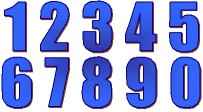
| Number | A word or symbol used to indicate how great any quantity is when compared with the unit quantity, one; a count, the sum, the size, the magnitude or the aggregate of quantities; the "how many" or "how long" or "how big" measurement, size or magnitude associated with a collection, an object, a thing or a quantity. Technically ... a 'number' is not the words or symbols that we use ... but the abstract concept which is referenced by the word or symbol. In common language and communication, however, we typically use the word 'number' interchangeably with the word 'numeral.' |
| Numeral: | the symbol (symbolism) or word(s) denoting (representing) a number. |
| Digit: | originally used to reference a finger or a finger's breadth (about 3/4 inch) ... used in mathematics to reference the original counting (natural) numbers or numerals: 1, 2, 3, 4, 5, 6, 7, 8, 9 and 0 ... so-called from counting on the fingers ... the digit '0' normally brought into play as the value ten (10), the tenth finger ... and the words and symbolism used to represent these particular counting numbers that correspond to counting the fingers on both hands. |
| Cardinal Number | any number used in counting or used in showing how many or what quantity (ex: two, 6, thirty, 125, etc.) ... distinguished from ORDINAL NUMBER; the natural numbers; the positive integers; the positive whole numbers. |
| Ordinal Number | any number used to indicate rank order (ex:: first, 3rd, fifth, 9th, etc.) in a particular series: distinguished from Cardinal Numbers; referencing a position, location or finish (ex: The fourth house on the block, the 6th letter in the alphabet; the eighth person in line, etc.) |
| Natural Numbers
Positive Integers Positive Whole Numbers: |
- the counting numbers 1, 2, 3, 4, etc; numbers produced by counting whole units or quantities (ex: five apples, 3 tables, 9 chairs, etc.); non-fractions, non-decimals and non-negatives. Other: Technically, the number zero (naught) is not a part of the Natural Number Set but is important and used in terms of place value. The number "30" is comprised of three groups of size ten and no units. The "3" indicates the size or number of groups of ten ... while the "0" indicates no further units. |
|
Prime numbers |
A PRIME number is a positive integer (positive whole number, counting number, natural number) that is evenly divisible by only one and itself; a whole number is called prime if its only factors are one and itself. The number
"1" ... while meeting this definition (explanation) is NOT considered to be prime ... the number "2" is normally considered to be the first prime number. The technical definition in many math textbooks for prime is: "a positive integer greater than 1 and
having no positive integral divisors other than itself and unity."
( 2, 3, 5, 7, 11, 13, 17, 19, 23, 29, 31, 37 ) |
|
Positive and Negative numbers |
Those who have been away from using mathematical concepts for a while often have trouble combining positive and negative numbers. Look at the picture below: Negative numbers are illustrated branching away from zero to the left. Positive numbers branch away to the right. The whole line, though, represents increasing values from left to right. Yes, that means that -2 is a bigger number than -5. Consider this line a thermometer then you will see that -2 degrees is warmer than -5 degrees. (Not much warmer, but warmer) |
| Mixed number | Mixed numbers have a whole number part and a fraction part.
Mixed numbers also written as 2 3/4 and 6 1/2. |